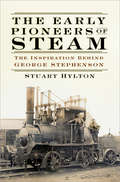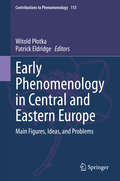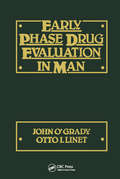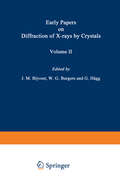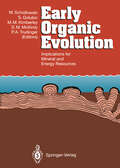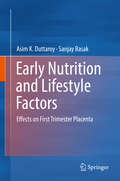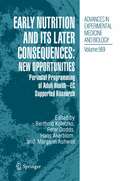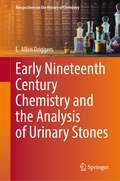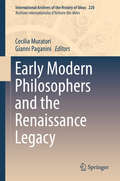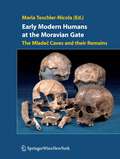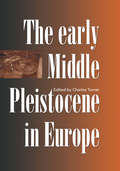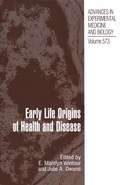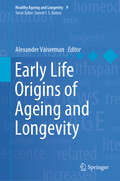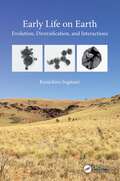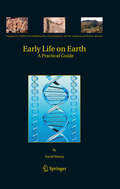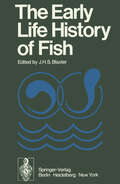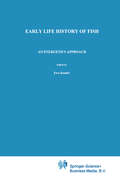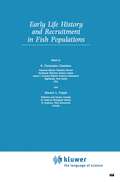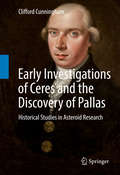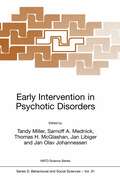- Table View
- List View
The Early Pioneers of Steam: The Inspiration Behind George Stephenson
by Stuart HyltonWE think of the Stephensons and Brunel as the fathers of the railways, and their Liverpool and Manchester and Great Western Railways as the prototypes of the modern systems. But who were the railways’ grandfathers and great-grandfathers? The rapid evolution of the railways after 1830 depended on the juggernauts of steam locomotion being able to draw upon centuries of experience in using and developing railways, and of harnessing the power of steam. Giants the Stephensons and others may have been, but they stood upon the foundations built by many other considerable – if lesser-known – talents. This is the story of those early pioneers of steam.
Early Phenomenology in Central and Eastern Europe: Main Figures, Ideas, and Problems (Contributions to Phenomenology #113)
by Witold Płotka Patrick EldridgeThis book presents the origins of Central and Eastern European phenomenology. It features chapters that explore the movement's development, its most important thinkers, and its theoretical and historical context. This collection examines such topics as the realism-idealism controversy, the status of descriptive psychology, the question of the phenomenological method, and the problem of the world.The chapters span the first decades of the development of phenomenology in Czechoslovakia, Poland, Romania, Russia, and Yugoslavia before World War II. The contributors track the Brentanian heritage of the development. They show how this tradition inspired influential thinkers like Celms, Špet, Ingarden, Frank, Twardowski, Patočka, and others. The book also puts forward original investigations. Moreover it elaborates new accounts of the foundations of phenomenology. While the volume begins with the Brentanian heritage, it situates phenomenology in a dialogue with other important schools of thought of that time, including the Prague School and Lvov-Warsaw School of Logic.This collection highlights thinkers whose writings have had only a limited reception outside their home countries due to political and historical circumstances. It will help readers gain a better understanding of how the phenomenological movement developed beyond its start in Germany. Readers will also come to see how the phenomenological method resonated in different countries and led to new philosophical developments in ontology, epistemology, psychology, philosophy of culture, and philosophy of religion.
Early Phase Drug Evaluation in Man
by John O’Grady; Otto I. LinetEarly Phase Drug Evaluation in Man is a comprehensive, practical guide that covers pre-clinical information relevant to early human studies, including pharmaceutical, metabolic, toxicological, and regulatory aspects, as well as the general considerations relevant to all early human studies. Each major therapeutic area is considered by class of activity of drug. The chapters describe what measurements of drug activity are available in healthy human subjects and in patients, how to make the measurements, their value and their limitations. The contributors have been drawn internationally from the pharmaceutical industry and academia. Early Phase Drug Evaluation in Man will provide an important reference guide for industry and academic professionals involved in the development of new drugs.
Early Phase Drug Evaluation in Man
by John O'Grady Otto I. LinetEarly Phase Drug Evaluation in Man is a comprehensive, practical guide that covers pre-clinical information relevant to early human studies, including pharmaceutical, metabolic, toxicological, and regulatory aspects, as well as the general considerations relevant to all early human studies. Each major therapeutic area is considered by class of activity of drug. The chapters describe what measurements of drug activity are available in healthy human subjects and in patients, how to make the measurements, their value and their limitations. The contributors have been drawn internationally from the pharmaceutical industry and academia. Early Phase Drug Evaluation in Man will provide an important reference guide for industry and academic professionals involved in the development of new drugs.
Early Papers on Diffraction of X-rays by Crystals: Volume 2
by J. M. Bijvoet W. G. Burgers G. HäggIn the Preface to Early Papers on Diffraction of X-rays by Crystals Volume I (containing Chapters I-V and published in 1969), the history and planning of the complete book were outlined. The publication in two separate and consecutive volumes was merely a matter of management; the compilation of both volumes was done at the same time. There is a distinct difference in subject-matter between both volumes: Volume I contains the fundamentals of the theory, while Volume II treats the practical development of the 'trial' -method and the genesis and first applications of the Fourier method. In the period covered by Early Papers (1912-1935), the trial method leads to the successful conquest of structures with up to a hundred parameters. We conclude the book with Patterson's discovery (1934) of the p2-series as described in his second, more detailed and extended paper of 1935. With this method the apparatus was completed which led to the present undreamt-of successes of the Fourier method in the field of organic chemistry. We have considered the inclusion of Robertson's famous synthesis of the structure of phtalocyanine (1936). However, we decided that its proper place would be at the beginning of a book which, no doubt, will appear one day, describing this later period. Considerations of space caused us to give up the chapter on Texture planned at first.
Early Organic Evolution: Implications for Mineral and Energy Resources
by Philip A. Trudinger Manfred Schidlowski Stjepko Golubic Michael M. Kimberley David M. McKirdyThis volume is the final outcome of a conference designed to wrap up IOCP Project 157 (" Early Organic Evolution and Mineral and Energy Resources ") after a decade of prolific activity. The picturesque solitude of Maria Laach Abbey in the Eifel Mountains (FRO) provided the appropriate setting for a conclave of some 80 specialists from the various walks of the field who, during the week of Sept. 19 - 23, 1988, strived hard to define the state of the art in the principal segments of this Earth Science frontier. The following pages contain the essence of the conference transactions, giv ing a vivid cross-section of the activities pursued by IOCP Project 157 during its final years. The coverage of topics is not necessarily complete, but rather eclec tic in part. With regard to single papers dealing with modern analogues of ancient processes, the book title might even be considered a grave misnomer. Neverthe less, all contributions relate to the subject in the widest sense, and the reader should be reminded that much of the heterogeneity reflected by the volume de rives from the fact that it is primarily a research report from a highly inter disciplinary field rather than a textbook.
Early Nutrition and Lifestyle Factors: Effects on First Trimester Placenta
by Asim K. Duttaroy Sanjay BasakThis book highlights the impact of nutrients on early placentation processes and their relevance for fetal growth and pregnancy outcome. The role of maternal nutrition on fetal growth and development has been evidenced in many epidemiological studies that included infamous Dutch famine, Helsinki Birth cohort and others. Fetal programming hypothesis states that the nutritional and other environmental conditions under which an individual develops from pre-conception to birth has a major impact on the future health of the newborn child. The developmental environment of the fetus is primarily dependent on two major factors that are maternal nutritional state (excess/low/imbalance) and placental function. Placentation is characterized by the extensive remodeling of the maternal uterine vasculature producing low-resistance blood vessels that facilitate the exchange of nutrients and wastes between the mother and the fetus. Cellular and molecular mechanisms involved in human placental blood vessel formation, which are now well established, are discussed.
Early Nutrition and its Later Consequences: Perinatal Programming of Adult Health - EC Supported Research (Advances in Experimental Medicine and Biology #569)
by Berthold Koletzko Hans Akerblom Margaret Ashwell Peter DoddsHealth problems such as hypertension, tendency to diabetes, obesity, blood lipids, vascular disease, bone health, behaviour and learning and longevity may be ‘imprinted’ during early life. This process is defined as ‘programming’ whereby a nutritional stimulus operating at a critical, sensitive period of pre and postnatal life imprints permanent effects on the structure, physiology and metabolism. For this reason, academics and industry set-up the EC supported Scientific Workshop -Early Nutrition and its Later Consequences: New Opportunities. The prime objective of the Workshop was to generate a sound exchange of the latest scientific developments within the field of early nutrition to look for opportunities for new preventive health concepts. Further, a closer look was taken at the development of food applications which could provide (future) mothers and infants with improved nutrition that will ultimately lead to better future health. The Workshop was organised by the Dept. of Pediatrics, University of Munich, Germany in collaboration with the Danone Institutes and the Infant Nutrition Cluster, a collaboration of three large research projects funded by the EU.
Early Nineteenth Century Chemistry and the Analysis of Urinary Stones (Perspectives on the History of Chemistry)
by E. Allen DriggersThis book tells the story of how chemists, physicians, and surgeons attempted to end the problem of urinary stones. From the late eighteenth to the early nineteenth centuries, chemists wanted to understand why the body formed urinary, pancreatic, and other bodily stones. Chemical analysis was an exciting new means of understanding these stones and researchers hoped of possibly preventing their formation entirely. Physicians and surgeons also hoped that, with improved chemical analysis, they would eventually identify substances that would reduce the size of stones, leading to their easier removal from the body. Urinary stones and other stones of the body caused the boundaries of surgery, chemistry, and medicine to blur. The problem of the stone was transformational and spurred collaboration between chemistry and medicine. Some radical physicians in America and Britain combined this nascent medical advancement with older disciplines, like humoral theory. Chemists, surgeons, and physicians in Charleston, Philadelphia, and London focused on the stones of the body. Chemical societies and museums also involved themselves in the problem of the stone. Meanwhile, institutions in Charleston, Philadelphia, and London served as repositories of specimens for testing and study as previously disparate practitioners and disciplines worked toward the comprehensive knowledge that could, perhaps, end suffering from stones. The primary audience of this book is historically-minded chemists, surgeons, physicians, and museum professionals.
Early Modern Philosophers and the Renaissance Legacy (International Archives of the History of Ideas / Archives internationales d'histoire des idées #220)
by Cecilia Muratori Gianni PaganiniWhen does Renaissance philosophy end, and Early Modern philosophy begin? Do Renaissance philosophers have something in common, which distinguishes them from Early Modern philosophers? And ultimately, what defines the modernity of the Early Modern period, and what role did the Renaissance play in shaping it? The answers to these questions are not just chronological. This book challenges traditional constructions of these periods, which partly reflect the prejudice that the Renaissance was a literary and artistic phenomenon, rather than a philosophical phase.The essays in this book investigate how the legacy of Renaissance philosophers persisted in the following centuries through the direct encounters of subsequent generations with Renaissance philosophical texts. This volume treats Early Modern philosophers as joining their predecessors as ‘conversation partners’: the ‘conversations’ in this book feature, among others, Girolamo Cardano and Henry More, Thomas Hobbes and Lorenzo Valla, Bernardino Telesio and Francis Bacon, René Descartes and Tommaso Campanella, Giulio Cesare Vanini and the anonymous Theophrastus redivivus.
Early Modern Humans at the Moravian Gate: The Mladec Caves and their Remains
by Maria Teschler-NicolaEarly Military Rifles: 1740–1850 (Weapon)
by Balázs NémethThe conduct of combat operations in open order during the 18th and 19th centuries required an improved firearm with more accuracy than the standard-issue smoothbore infantry musket. Consequently, the appearance of a new type of regular light infantry soldier and an innovative military firearm, the rifle, marked a new age in the history of warfare. During the 18th century both Austria and Prussia fielded light troops armed with rifled firearms, while conflicts in North America involved the deadly long rifle and the innovative Ferguson breech-loader. Rifle-armed specialists also fought for several nations during the Napoleonic Wars. However, it was the decades after 1815 that saw the appearance of successful rifled percussion firearms, paving the way for the widespread issue of rifled weapons. This development was accelerated by the Prussian adoption of the Dreyse 'needle gun' in 1848 and in 1849, the French Minié rifle was the first successful conical ball rifle concept to be issued to regular troops in large numbers. Illustrated throughout with stunning full-colour artwork, this study charts the development, combat use, influence and legacy of rifled firearms in a host of conflicts, from the War of the Austrian Succession of 1740–48 to the Mexican–American War of 1846–48.
Early Military Rifles: 1740–1850 (Weapon #76)
by Balázs NémethThe conduct of combat operations in open order during the 18th and 19th centuries required an improved firearm with more accuracy than the standard-issue smoothbore infantry musket. Consequently, the appearance of a new type of regular light infantry soldier and an innovative military firearm, the rifle, marked a new age in the history of warfare. During the 18th century both Austria and Prussia fielded light troops armed with rifled firearms, while conflicts in North America involved the deadly long rifle and the innovative Ferguson breech-loader. Rifle-armed specialists also fought for several nations during the Napoleonic Wars. However, it was the decades after 1815 that saw the appearance of successful rifled percussion firearms, paving the way for the widespread issue of rifled weapons. This development was accelerated by the Prussian adoption of the Dreyse 'needle gun' in 1848 and in 1849, the French Minié rifle was the first successful conical ball rifle concept to be issued to regular troops in large numbers. Illustrated throughout with stunning full-colour artwork, this study charts the development, combat use, influence and legacy of rifled firearms in a host of conflicts, from the War of the Austrian Succession of 1740–48 to the Mexican–American War of 1846–48.
The Early Middle Pleistocene in Europe
by Charles TurnerThese papers show how new research in the classic areas and Germany, but particularly in Eastern Europe, is radically altering views of the stratigraphy and palaeocology of the early-middle Pleistocene period, showing that major glaciations did not begin only in the late- middle Pleistocene.
The Early Middle Pleistocene in Europe
by Charles TurnerThese papers show how new research in the classic areas and Germany, but particularly in Eastern Europe, is radically altering views of the stratigraphy and palaeocology of the early-middle Pleistocene period, showing that major glaciations did not begin only in the late- middle Pleistocene.
Early Life Origins of Health and Disease (Advances in Experimental Medicine and Biology #573)
by E. Marelyn Wintour-Coghlan Julie OwensEarly Life Origins of Health and Disease is a new book which presents and discusses the many factors that may have impact on normal development. In a concise and readable manner, the authors consider both the proven and suggestive evidence that the high prevalence of hypertension, diabetes, obesity and, in some populations, kidney disease, may not be all due to genetics or adult environment alone. There is good evidence that stress and more subtle dietary deficiencies, as well as placental malfunction, may increase the risk that the offspring will develop these problems in later life. Finally, new and emerging evidence for other areas of human health and disease such a motor control and mental health is critically reviewed for the first time. The book is a ‘must’ for all scientists interested in researching these areas, as there is a critical evaluation of the methodology used and suggestions for the ‘optimal’ way in which to investigate these phenomena.
Early Life Origins of Ageing and Longevity (Healthy Ageing and Longevity #9)
by Alexander VaisermanThis book provides a comprehensive overview of the field of developmental programming of ageing phenotypes. Although gerontological research has traditionally focused on later stages of the life cycle, growing evidence indicates that both the rate of ageing-associated functional declines, and the risks of later-life chronic pathological conditions, can be traced to origins early in life. While other books in the field concentrate on the developmental origin of particular disorders, this volume offers a detailed guide to all important aspects of the role of early-life conditions in programming both chronic pathological conditions and the ageing process.Interest in the study of ageing and longevity had its beginnings in research on the fetal origins of adult disease. This has evolved into a hypothesis on the Developmental Origins of Adult Health and Disease (DOHaD), which postulates that adverse environmental exposures during critical in-utero and early postnatal stages of development may permanently change physiological responses and cause functional impairments and disorders in adult life. In this book, the contributing authors and leading experts from around the world, describe research on mechanisms underlying the developmental programming phenomenon, as well as interventional strategies aimed at restoring developmentally disrupted epigenetic patterns. Early Life Origins of Ageing and Longevity benefits a wide audience of working scientists, clinicians, and advanced students, and will also interest scientifically curious general readers who wish to know more about current research in this rapidly evolving field.
Early Life on Earth: Evolution, Diversification, and Interactions
by Kenichiro SugitaniThis book comprehensively explores the early evolution of life and the Archean environment. Topics include the differences between prokaryotes and eukaryotes, variations in metabolisms, concepts of ecosystems and biogeochemical cycles (nitrogen, sulfur, phosphorous), Archean geology and environments, and the widely accepted early evolutionary history of life. The text addresses controversies regarding early life and its environment, particularly the unusual microfossil assemblages from the 3.4 Ga Strelley Pool Formation and the 3.0 Ga Farrel Quartzite of Western Australia. Readers will get a fuller picture of the Archean world, and an appreciation of many still unresolved questions. Key Features Illustrated with figures visualizing ecosystems, biogeochemical cycles etc which are indispensable for understanding the Archean Earth. Includes tables arranging key words, definitions, and interpretations. Documents the Archean environment with photographic evidence and detailed descriptions the rocks, minerals and microfossils. Summarizes the latest field research. Details exciting unresolved questions for future study.
Early Life on Earth: Evolution, Diversification, and Interactions
by Kenichiro SugitaniThis book comprehensively explores the early evolution of life and the Archean environment. Topics include the differences between prokaryotes and eukaryotes, variations in metabolisms, concepts of ecosystems and biogeochemical cycles (nitrogen, sulfur, phosphorous), Archean geology and environments, and the widely accepted early evolutionary history of life. The text addresses controversies regarding early life and its environment, particularly the unusual microfossil assemblages from the 3.4 Ga Strelley Pool Formation and the 3.0 Ga Farrel Quartzite of Western Australia. Readers will get a fuller picture of the Archean world, and an appreciation of many still unresolved questions. Key Features Illustrated with figures visualizing ecosystems, biogeochemical cycles etc which are indispensable for understanding the Archean Earth. Includes tables arranging key words, definitions, and interpretations. Documents the Archean environment with photographic evidence and detailed descriptions the rocks, minerals and microfossils. Summarizes the latest field research. Details exciting unresolved questions for future study.
Early Life on Earth: A Practical Guide (Topics in Geobiology #31)
by David WaceyWhen did life first appear on Earth and what form did it take? The answer to this intriguing and fundamentally important question lies somewhere within the early Archean rock record. The young Earth was, however, a very different place to that we know today and numerous pitfalls await our interpretation of these most ancient rocks. The first half of this practical guide equips the reader with the background knowledge to successfully evaluate new potentially biological finds from the Archean rock record. Successive steps are covered, from locating promising samples in the field, through standard petrography and evaluation of antiquity and biogenicity criteria, to the latest state of the art geochemical techniques. The second half of the guide uniquely brings together all the materials that have been claimed to comprise the earliest fossil record into an easily accessible, fully illustrated format. This will be a handbook that every Archean geologist, palaeobiologist and astrobiologist will wish to have in their backpack or on their lab-bench.
The Early Life History of Fish: The Proceedings of an International Symposium Held at the Dunstaffnage Marine Research Laboratory of the Scottish Marine Biological Association at Oban, Scotland, from May 17–23, 1973
by J. H. S. BlaxterPlans for an International Symposium on the Early Life History of Fish were first discussed in 1967 at the F. A. O. Advisory Committee on Marine Resources Research {A. C. M. R. R. }. It was considered that studies on fish eggs and larvae were of value in estimating the size of fish stocks, in appraising the stock-recruitment relationship, and in helping to answer questions on the systematics and taxonomy of fish. An A. C. M. R. R. Working Party recommended in 1969 that a Symposium should be held and after discussion with the International Associa tion of Biological Oceanography {I. A. B. O. } Dr. J. H. S. Blaxter of the Scottish Marine Biological Association {S. M. B. A. } agreed to con vene the meeting with the help of a steering committee. Various in ternational agencies were interested in the meeting and agreed to sponsor it in various ways. These agencies included F. A. O. , I. A. B. O. , the International Council for the Exploration of the Sea {I. C. E. S. } and the Scientific Committee for Oceanic Research {S. C. O. R. }. In the final event F. A. O. supported the meeting by publishing the abstracts beforehand, providing travel funds for participants and publishing a report after the meeting. I. A. B. O. and S. C. O. R. provided travel funds and the Royal Society of London and S. M. B. A.
Early Life History of Fish: An energetics approach (Fish & Fisheries Series #4)
by E. KamlerAmong the fishes, a remarkably wide range of biological adaptations to diverse habitats has evolved. As well as living in the conventional habitats of lakes, ponds, rivers, rock pools and the open sea, fish have solved the problems of life in deserts, in the deep sea, in the cold Antarctic, and in warm waters of high alkalinity or of low oxygen. Along with these adaptations, we find the most impressive specializations of morphology, physiology and behaviour. For example we can marvel at the high-speed swimming of the marlins, sailfish and warm-blooded tunas, air breathing in catfish and lungfish, parental care in the mouth-brooding cichlids and viviparity in many sharks and toothcarps. Moreover, fish are ofconsiderable importance to the survival ofthe human species in the form of nutritious and delicious food of numerous kinds. Rational exploitation and management of our global stocks of fishes must rely upon a detailed and precise insight of their biology. The Chapman and Hall Fish and Fisheries Series aims to present timely volumes reviewing important aspects of fish biology. Most volumes will be of interest to research workers in biology, zoology, ecology and physiology, but an additional aim is for the books to be accessible to a wide spectrum ofnon specialist readers ranging from undergraduates and postgraduates to those with an interest in industrial and commercial aspects of fish and fisheries.
Early Life History and Recruitment in Fish Populations (Fish & Fisheries Series #21)
by R. C. Chambers Edward A. TrippelMany of the processes influencing recruitment to an adult fish population or entry into a fishery occur very early in life. The variations in life histories and behaviours of young fish and the selective processes operating on this variation ultimately determine the identities and abundance of survivors. This important volume brings together contributions from many of the world's leading researchers from the field of fish ecology. The book focuses on three major themes of pressing importance in the analysis of the role that the early life history of fishes plays in the number and quality of recruits: the selective processes at play in their early life history; the contributions of early life history to the understanding of recruitment.
Early Investigations of Ceres and the Discovery of Pallas: Historical Studies in Asteroid Research
by Clifford CunninghamAn asteroid scholar, Cunningham in this book picks up where his Discovery of the First Asteroid, Ceres left off in telling the story of the impact created by the discovery of this new class of object in the early 1800s. The best and brightest minds of mathematics, science, and philosophy were fascinated by Ceres, and figures as diverse as Gauss, Herschel, Brougham, Kant, and Laplace all contributed something to the conversation. The first few chapters deal with the mathematical and philosophical aspects of the discovery, and the rivalry between Germany and France that so affected science and astronomy of that era. The jockeying for glory over the discovery of Ceres by both Piazzi and Bode is examined in detail, as is the reception given to Herschel’s use of the word 'asteroid.' Archival research that reveals the creator of the word 'asteroid' is presented in this book. Astronomy was a truly cosmopolitan field at the time, spanning across various disciplines, and the discovery of Pallas, a story completely told in these pages, exemplifies the excitement and drama of early 1800s astronomy. All the private correspondence about the study of Ceres and Pallas in 1802 is given here, which helps to contextualize and personalize the discovery.
Early Intervention in Psychotic Disorders (NATO Science Series D: #91)
by Tandy Miller, Sarnoff A. Mednick, Thomas H. McGlashan, Jan Libiger and Jan Olav JohannessenMultiple voices throughout the last century have preached the merits of various treatments for schizophrenia, ranging from cold baths to the currently accepted standards such as neuroleptic medication. Along with these ongoing treatments, there have been quiet commentaries, made mostly from the sidelines, suggesting the need to shift and refocus the way we think and talk about schizophrenia. Harry Stack Sullivan noted in 1927 that, 'The psychiatrist sees too many end states and deals professionally with too few of the pre psychotic" (Sullivan 192711994, p. 135). Similar thoughts have been echoed by purveyors of modem treatment for psychosis such as Thomas H. McGlashan: "Like others before me, I tried to make a difference . . . but like the others my efforts were largely in vain. I came upon the scene too late; most of the damage was already done" (McGlashan, 1996). Similar interest in the early phase of schizophrenia has developed across the globe and consolidated into a tentative, yet meaningful deliberation about the potential for prevention of psychotic illness through early identification and intervention. In the past decade, international support has grown from: Ian Falloon's prodromal intervention project in Great Britain (Falloon et aI. , 1996); Patrick McGorry's and Jane Edward's first episode psychosis program in Melbourne, Australia (McGorry et al.
